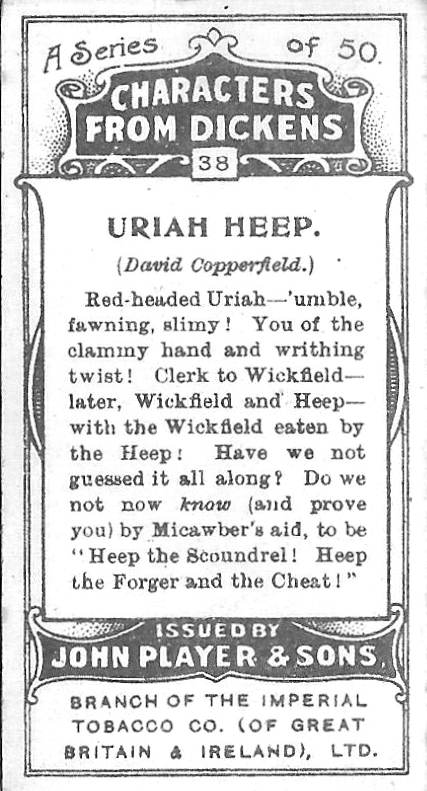Uriah Heep
J. Clayton Clarke ("Kyd")
1910
Watercolour reproduced on John Player cigarette card no. 38
Scanned image and text by Philip V. Allingham
[You may use this image without prior permission for any scholarly or educational purpose as long as you (1) credit the person who scanned the image and (2) link your document to this URL in a web document or cite the Victorian Web in a print one.]
In Kyd's sequence of fifty cards, fully 13 or over 25% concern a single novel, The Pickwick Papers, attesting to the enduring popularity of the picaresque comic novel and also suggesting that the later, darker novels such as Our Mutual Friend (two characters) and The Mystery of Edwin Drood (no characters depicted) offered little for the caricaturist, the only late characters in the series being the singularly unpleasant and physically odd Silas Wegg and the rough waterman Rogue Riderhood from Our Mutual Friend, and Turveydrop, Jo, Bucket, and Chadband from Bleak House. The popular taste was clearly still towards the earlier farce and character comedy of Dickens. The series, however, includes a total of six character cards from the cast of David Copperfield (May 1849 through November 1850), or 12% of the total: the affable master of English rhetoric Wilkens Micawber, no. 41; the oppressed child who becomes a novelist, David Copperfield, no. 39; the rigid and mean-spirited Mr. Murdstone, no. 37; the crotchety but warm-hearted Betsey Trotwood, no. 36; the devious, unctuous Uriah Heep, no. 38; and the stalwart pater familias Dan' Peggotty, no. 40 — characterisations based on the original serial illustrations of Dickens's regular visual interpreter in the 1840s, Phiz, who produced forty steel-engravings and the wrapper design for the Bradbury and Evans nineteen-month serial, as well as a wood-engraved frontispiece of Little Em'ly and David as children on the Yarmouth sands for the first cheap edition (1858) and two vignettes for the two-volume Library Edition: Little Em'ly and David by the Sea and Mr. Peggotty's Dream Comes True.
Although Kyd's representations are largely based on the original illustrations by Hablot Knight Browne (Phiz), the modelling of the figures is suggestive of those of celebrated Dickensian illustrator Fred Barnard for the Household Edition, volume 3 (1871). The anomaly, of course, is that Kyd should elect to depict minor figures from the first Dickens novel such as the Dingley Dell cricketers Dumkins and Luffey and the minor antagonist Major Bagstock in Dombey and Son, but omit significant characters from such later, still-much-read novels as A Tale of Two Cities and Great Expectations. Five of the fifty cards or 10% of the series come from the cast of The Adventures of Oliver Twist; or, The Parish Boy's Progress (1837-39): Oliver himself, asking for more; Fagin with his toasting fork, from the scene in which he prepares dinner for his crew; Sikes holding a beer-mug, and the Artful Dodger in an oversized adult topcoat and crushed top-hat, as he appeared at his trial. Surprisingly, some of the other significant characters, including Nancy and Rose Maylie, are not among the first set of fifty characters, in which Kyd exhibits a strong male bias, as he realizes only seven female characters: only the beloved Nell, the abrasive Sally Brass, and the quirky Marchioness from The Old Curiosity Shop, Sairey Gamp from Martin Chuzzlewit, Aunt Betsey Trotwood from David Copperfield, the burly Mrs. McStinger from Dombey and Son, and the awkward Fanny Squeers from Nicholas Nickleby appear in the essentially comic cavalcade.
Kyd's model for the evil twin in David's modern fairy tale was likely Phiz's study of the devious law clerk and his master consulting their client, David's Aunt Betsey, in David's London bachelor rooms in Mr. Wickfield and his partner wait upon my Aunt (April 1850: Chapter 35). However, Kyd had one other Phiz model from which to realise David's former rival for Agnes Wickfield, in I am shewn two interesting penitents (November 1850: Chapter 61), in which the supposedly repentant Uriah (down left) deceives the gentlemen who are the prison governors. The fin-de-siecle illustrator may also have studied the devious attorney in the wood-engravings of Fred Barnard for the Household Edition volume 3 (1872), particularly the half-page wood engraving depicting David's aunt chastizing Uriah for his unctuous writhing, "Deuce take the man!" said my aunt, sternly, "What's he about? Don't be galvanic, Sir!" g (Chapter XXXV, "Depression"). In all likelihood, as a British artist Kyd never saw an 1867 Diamond Edition volume of the novel, and therefore was not influenced by Sol Eytinge, Junior's Uriah Heep and His Mother, whose image of the close-cropped humble clerk is not quite so lank and obsequious as Phiz's original conception and Barnard's revision — which, significantly, likewise includes Uriah's customary wringing of his hands and uncomfortably smiling.
Victorian
Web
Visual
Arts
Illus-
tration
Kyd
Next
Created 14 January 2015

